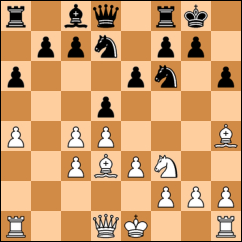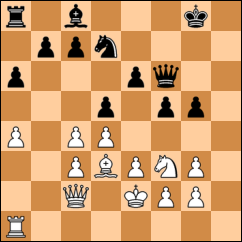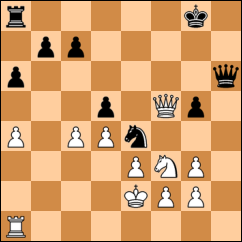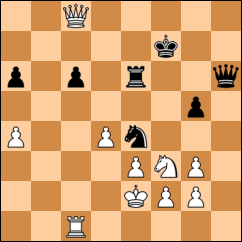K.Ammann–S.McWhirter
Route 20 Chess Club
Freeport, Ill., Feb. 8, 2011
1.d4 d5 2.c4 e6 3.Nc3 Nf6 4.Nf3 Bb4 5.Bg5
Up to here, it's all textbook.
5...0-0?
A mistake only in the sense that it passes up the opportunity to take my c-pawn without immediate repercussion, which would give him time to do other things (or secure his own pawn from recapture).
6.e3 a6
Preparing ...b5, but this is not necessarily the most important thing for Steve to be doing. 6...Nbd7, 6...h6 or 6...c5 is the most effective way to fight back.
7.a4 Nbd7 8.Bd3 h6 9.Bh4 Bxc3+ 10.bxc3
This is the next chance Steve has to liquidate my c-pawn. Actually, in a sense, it's the next five chances, all of which he passes up.
10...g5 11.Bg3 Ne4 12.Qc2 Nxg3 13.hxg3 f5?
Of those five chances to play ...dxc4, two may be described as critical. This is the first. Even though I've constructed a battery along the b1-h7 diagonal, I can't do much with it yet, so this blocking move is unnecessary.
14.Rxh6
Meanwhile, my own play, tight so far, begins to slacken. There's nothing wrong with this move, grabbing a hanging pawn and making Steve's king sweat bullets, except to the extent that it's even better after laying some groundwork: 14.cxd5! g4 15.Nh4 exd5 16.Nxf5 Nf6 17.Rxh6 Bxf5 18.Bxf5, with a big advantage for white.
14...Rf6
I ponder this challenge. Controlling the h-file is nice, but I am a pawn up, and I can easily mobilize my other rook to the kingside, while Steve can't. I decide it's worth it to eliminate this potential bodyguard.
15.Rxf6 Qxf6 16.Ke2
Being wrapped up in my plan to redeploy my a1-rook to the kingside, I neglect to consider the all-important 16.cxd5 for myself.
16...Qh6?
Steve sees my plan and thwarts it. But this is the second critical moment at which ...dxc4 outweighs everything else.
17.cxd5
And the window of opportunity slams shut, as I observe that trading pawns on d5 restores my backward c-pawn to full vigor.
17...Nf6
Instead of recapturing! Undoubtedly, Steve sees 17...exd5 18.Bxf5 and doesn't like it, or maybe he's reacting to the continuation 18...c6 19.c4 dxc4 20.Qxc4+. But 18.dxe6 Bxe6 19.Bxf5 is even worse for black.
18.c4
Too bad I don't think of it.
18...exd5 19.Bxf5 Bxf5 20.Qxf5 Ne4
21.cxd5
Not bad, but 21.Qxd5+! Kf7 22.Qxe4 cripples black permanently.
21...Re8 22.Rc1
I contemplate 22.Qd7, with the idea of mowing down Steve's pawns (22...Nf6 23.Qxc7 Nxd5 24.Qxb7) but then conclude that putting my rook on the c-file kills Steve's c-pawn just as dead while also activating my last undeveloped piece. But 22.Ne5!, cutting support for the e4-knight, followed by 22...Nd6 23.Qd7 is best.
22...c6 23.dxc6 bxc6 24.Qd7
So pretty -- yet 24.Ne5 is still better. I'm hesitating to move that knight from where it's sitting, even to a textbook outpost, because I believe it's providing valuable cover for my king. But what happens if Steve does check me? 24.Ne5 Qh5+?! 25.g4 Qh7 26.Rxc6!, fin.
24...Re6 25.Qc8+ Kf7
This is not what I expected when I played 25.Qc8+. I figured Steve would play 25...Kg7 (the superior retreat), and I'd simply pick off his a-pawn. But with his king on f7, suddenly 26.Ne5+ is extremely tempting. Does it work? I feel like it should, but I can't prove it to my own satisfaction (beyond noting that 26...Kg7 is the only retreat that works), and that fear of ...Qh5+ rears its head again. Do I go for the sure thing, or do I try to be slick? Bad things often happen when I try to get slick. I opt to play it safe.
In this case, though, slick wins big. 26.Ne5+!! Rxe5 27.dxe5 wins the exchange and gives me a bona fide passed pawn; 26...Kg7 27.Qd7+ Kg8 28.Rh1! (it works because of 28...Qxh1?? 29.Qxe6+ Kh8 30.Qe8+ Kh7 31.Qg6+ Kh8 32.Nf7#) 28...Nc3+ 29.Kd3 Nxa4 leads to a forced mate; 26...Kf6?? drops the queen to a knight fork; and 26...Ke7 walks into a mating net (27.Qd7+ Kf8 28.Qf7#).
26.Qxa6 c5 27.Qc4
27.Ne5+!! is still a sledgehammer blow: 27...Kf8 28.Qc8+ Re8 29.Qf5+ Nf6 30.Rxc5, and black's pieces look like they're cowering.
27...Nd6 28.Qxc5 1-0
Steve, nearly out of time and with no way to save the game, resigns.








0 comments:
Post a Comment